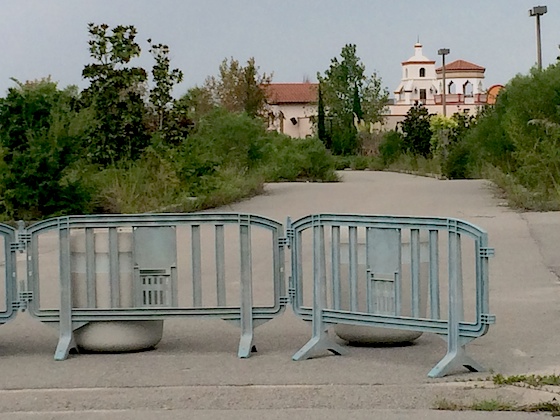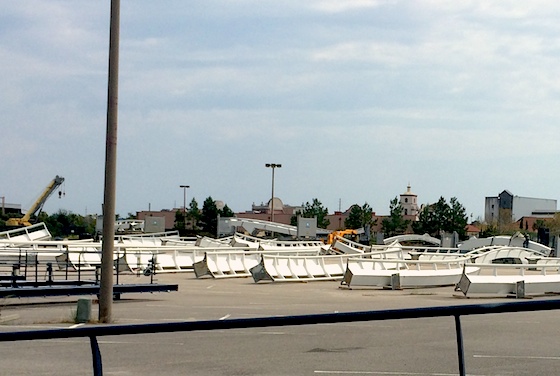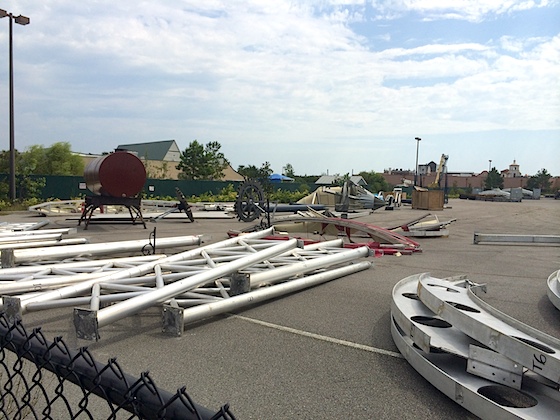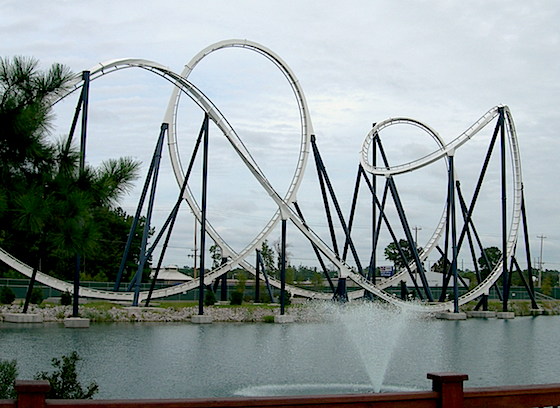After only one year of operation, so much promise turned into so much disappointment. A bad economy hampered tourist spending and killed the stock market. Poor pricing and marketing campaigns kept many customers either away or unaware of the park’s existence. Bad business deals led to lack of operating funds. With no money at the end of the season, no major company backing the park, and a frozen credit market, there was nothing left to weather the financial storm, and it was over. Subsequent attempts to rebrand and reopen the park were mired in bankruptcy court and lawsuits over previously abandoned intellectual property. In 2010 the brand new park was shuttered for good, relegated to SBNO status just two years into its existence.

Today, the B&M coaster formerly known as Led Zeppelin and then Time Machine now sits in pieces in the cracked and overgrown parking lot, reportedly sold along with the other flagship rides to a park in Asia. The construction cranes currently at work dismantling the rides are a final reminder to those who pass by of its failed promise. It really is a rather depressing sight, considering what was once there and what could have been.

The reasons for Hard Rock’s demise have more to do with economics and business and very little to do with creativity and design. The park was financed and built for less than $400 million, quite a feat considering the cost for infrastructure and the content they produced. I was fortunate enough to pay Hard Rock a visit on its very last day of operation in 2008. What I remember most about it was the quality and the little bit of edge that it had to it. It truly was a theme park, reminiscent of a not yet fully grown IOA. Some of the attractions were still fillers, and it needed a few years to mature and grow, but it had the bones of something great. Nights in White Satin remains to this day one of my favorite dark rides ever, and the park was full of neat visuals and ambience. The shows were entertaining, the staff was great, and the food was of good quality. The biggest thing missing from the day was the people. Makes me wonder what would have been if the creative team had a couple of years and money to play with.
We can blame two things for that…the recession and poor business. Management took a gamble and made a grave error in judgment. Highly confident in their product to say the least, they overpromised to investors and under-delivered to their bottom line, spending more than $100 million of the $385 million budget on finance costs and investor payoff and leaving the park highly leveraged with little cash to operate with. They sorely misjudged their marketplace with the ticket pricing. Anyone over 3 years old was charged the full price of $50, and that was about it. No starlight options, pricing for height, senior prices, discounts for locals…etc. While much of this pricing in the industry is somewhat of an illusion anyway, the lack of options and perceived value likely would have put off many of the Midwestern middle class families of 5 with little kids…in other words the largest demographic that visits the area. Perhaps the biggest misstep of all was the largely ineffective marketing campaign. The seven-city tour of the Magical Mystery Bus didn’t work because they didn’t really advertise the stop and concert that came with it. The free interactive preview center built at the park site hosted an underwhelming amount of people when compared to the tourist population, mostly because not many knew it existed. The center was never really marketed to the visitors in town, and when the park opened, management amazingly made almost no attempt to partner with any of the more than 450 hotels in the area in the park’s marketing, something that every other major attraction in the area does. By the time they had gotten wise to some of their errors, the season was almost over and the money was gone. The bad economy encouraged most of their investors to simply take a loss and leave the project.

In the wake of its initial bankruptcy, Hard Rock left scores of local businesses holding the bag, a bad taste that still remains to this day in the mouths of some. Out of the disaster of the first season came a group of former park employees to buy what was left. Having to abandon the Hard Rock name and the rights to specific band names and songs, the park reopened the following year as Freestyle Music Park. Soon after though, the park was mired in lawsuits from previous executives, seeking ownership of intellectual property and hobbling any attempts at a meaningful comeback. The park subsequently entered foreclosure, and then made one final appearance in pop culture on an episode of NBC’s “Revolution” as an abandoned theme park.

As the rides finally leave the site and the weeds continue to grow, people in the area can’t help but wonder what’s next. Inquiries about park hours continue to come in. Many people lament the passing of Hard Rock when they see the finality of the dismantled rides in the lot. The park industry in one of the largest tourist markets in the country still consists of a small seaside amusement park, a couple of small water parks, and collections of flat rides in a few places…not indicative at all of its potential. As of yet, there are no plans to redevelop or rehab the area, although people seem to be calling for something to happen. It seems that one of the most unfortunate industry stories in recent memory has finally come to a close.
More, from the Editor: Theme Park Insider readers saw trouble with Hard Rock Park two years before its opening. Here are the links where we picked apart Hard Rock Park's overly optimistic attendance projections, the park management shot back at us, and then we analyzed the park's failure, after the fact.
Read more about what the park was like with these in-person reports, one from the soft opening and another from the official grand opening for the media:
Tweet
Very surprised to see it closed so soon after opening.
If you build it, They might not come...
Thanks for the article, Derek, and for the reminder that "waiting for next year" is not always the best option.
Again, they have an incredibly exciting concept, a fairly solid long term vision, a shoe string budget, but no marketing concept which is ultimately why this failed.
This article has been archived and is no longer accepting comments.
This should be a case study in how hard it is to create a successful theme park from scratch. It seems so easy on Roller Coaster Tycoon, but it can be extremely difficult in the real world, even if you put the best people on the job. It's really sad that investors did not recognize the unrealistic goals the designers set for the park, because those investors would have seen the need to provide funding for a few years of park operations to allow them to establish a foothold and begin to grow the brand. As a huge fan of Shark Tank, I wonder what would happen if this concept were pitched to the Sharks today, and if they would see past the lofty goals to infuse such an innovative concept with the needed cash to turn a profit.
I still get looks from time to time when I wear my Led Zeppelin: The Ride shirt in theme parks around the country, and even had a brief discussion with an IOA employee who worked at Hard Rock Park and mourned its loss. It just goes to show that the business world can be very cruel to even the most innovative and amazing ideas.